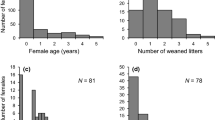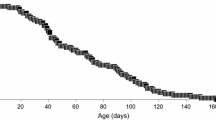Summary
An experiment was conducted to examine the relationship between reproduction and longevity in an annual iteroparous species of grasshopper, Melanoplus sanguinipes. Two hypotheses derived from life history theory were tested. These included: 1) virgin females produce fewer eggs and live longer than mated females, and 2) the rate of egg production and longevity are negatively related. The results of this study indicated that there is no trade-off between reproduction and longevity in this species of grasshopper. It is suggested that other factors, such as male-female interactions, may be more important in affecting female survival than reproduction.
Similar content being viewed by others
References
Calow P (1973) The relationship between fecundity, phenology and longevity: A systems approach. Amer Nat 107:559–574
Calow P (1979) The cost of reproduction — A physiological approach. Biol Rev 54:23–40
Cole LC (1954) The population consequences of life history phenomena. Quart Rev Biol 29:103–137
Dearn JM (1977) Variable life history characteristics along an altitudinal gradient in three species of Australian grasshoppers. Oecologia (Berl) 28:67–85
Drake CJ, Decker GC, Tauber OE (1945) Observations on oviposition and adult survival of some grasshoppers of economic importance. Iowa State College J Sci 19:207–223
Haukioja E, Hakala T (1978) Life-history evolution in Anodonta piscinalis (Mollusca, Pelecypoda). Oecologia (Berl) 35:253–266
Law R (1979) The cost of reproduction in annual meadow grass. Amer Nat 109:453–464
Loschiavo SR (1968) Effect of oviposition sites on egg production and longevity of Trogoderma parabile (Coleoptera: Dermestidae). Can Entomol 100:86–89
Mertz DB (1975) Senescent decline in flour beetle strains selected for early adult fitness. Physiol Zool 48:1–23
Murdoch WW (1966) Population stability and life history phenomenon. Amer Nat 100:5–11
Ricklefs RE (1977) On the evolution of reproductive strategies in birds: reproductive effort. Amer Nat 111:453–478
Snell TW, King CE (1977) Lifespan and fecundity patterns in rotifers: The cost of reproduction. Evol 31:882–890
Sokal RR, Rohlf FJ (1969) Biometry. WH Freeman and Co, San Francisco
Stearns SC (1970) Life history tactics: A review of the ideas. Quart Rev Biol 51:3–47
Tinkle DW (1969) The concept of reproductive effort and its relation to the evolution of life histories in lizards. Amer Nat 103:501–516
Tinkle DW, Wilbur HM, Tilley SG (1970) Evolutionary strategies in lizard reproduction. Evol 24:55–74
Williams GC (1966) Natural selection, the cost of reproduction and a refinement of Lack's principle. Amer Nat 100:687–690
Author information
Authors and Affiliations
Rights and permissions
About this article
Cite this article
Dean, J.M. The relationship between lifespan and reproduction in the grasshopper Melanoplus . Oecologia 48, 385–388 (1981). https://doi.org/10.1007/BF00346499
Received:
Issue Date:
DOI: https://doi.org/10.1007/BF00346499




